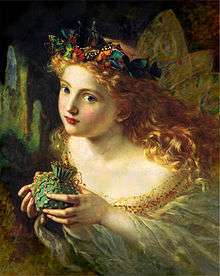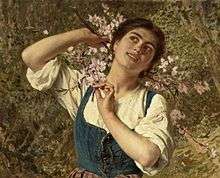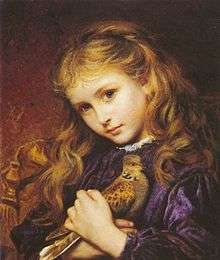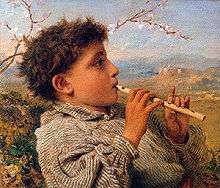Sophie Gengembre Anderson
| Sophie Gengembre Anderson | |
|---|---|
| Born |
Sophie Gengembre 1823 Paris, France |
| Died |
10 March 1903 Falmouth, Cornwall, England[1][2] |
| Resting place |
Falmouth Cemetery at Swanvale, Falmouth, England 50°8′46.08″N 5°4′38.73″W / 50.1461333°N 5.0774250°WCoordinates: 50°8′46.08″N 5°4′38.73″W / 50.1461333°N 5.0774250°W |
| Nationality | French-born Britain |
| Education | Charles de Steuben |
| Known for | Painting |
| Notable work | No Walk Today, The children's storybook, Elaine and others |
| Movement | Neoclassism, Italian genre paintings |
| Spouse(s) | Walter Anderson |
Sophie Gengembre Anderson (1823 – 10 March 1903) was a French-born British artist who specialised in genre painting of children and women, typically in rural settings. She began her career as a lithographer and painter of portraits, collaborating with Walter Anderson on portraits of American Episcopal bishops. Her work, Elaine, was the first public collection purchase of a woman artist. Her painting No Walk Today was purchased for more than £1 million.
Early life
Sophie was born in Paris, the daughter of Charles Antoine Colomb Gengembre, a French architect and artist, and his English wife, whose maiden name was Hubert.[3][4][nb 1]
They lived in Paris during the early years of Sophie's life, where her father was acquainted with artists, intellectuals, and actors, like François Joseph Talma. Circumstances required that the family leave Paris and live in a "remote area in France" from 1829 to 1843. At seventeen she developed an interest in art when a travelling portrait painter visited her town.[5]
She had two brothers, Philip and Henry P. Gengembre.[3] Her brother Philip changed his name to Philip Hubert, using his mother's maiden name, and was a successful architect in New York City.[4] She was largely self-taught in art, but briefly studied portraiture with Charles de Steuben in about 1843,[3] when she lived with family friends in Paris. Soon after she began her studies, he left for Russia and did not return within the one year allotted for her studies. She did develop relationships with other women artists at the school where she gained a little more instruction.[5]
United States

The family left France for the United States to escape the 1848 revolution,[6] first settling in Cincinnati, Ohio, where she met her future husband British genre artist Walter Anderson. Her brother Henry P. Gengembre (b. 1825) was also an artist, active in Cincinnati in the early 1850s.[3]
Her portrait, figure and Brittany landscape paintings were exhibited in October 1849 at the Western Art Union Gallery. Also exhibited was a three panel set of Victorian London scenes entitled The Ladder of Love, which was described as "the lady, in her flowery 'May of Life,' awaits in her father's garden a stolen interview with her lover; in the second, she is seen eagerly caught in his impatient arms, ere he has yet left the ladder upon which he surmounted the garden wall; in the third, having received and given reveals of unfaltering love, she walks alone again - beautiful in the enrobing light of a summer moon, happy in the assurance that the warmth and devotedness of her affection is reciprocated."[3]
Four or more of her illustrations were included in the Historical Collections of the Great West by Henry Howe. She collaborated with Walter Anderson, her future husband, on portraits of Protestant Episcopal bishops and created other portraits in her business.[3]
She then lived in Manchester, Pennsylvania with her parents, where she is believed to have married Walter Anderson.[3] She worked there for the chromolithographers Louis Prang & Company.[7]
Europe

In 1854 the Andersons moved to London, where Sophie exhibited a still life of fruit, vegetables, game and fish entitled An American Market Basket at the Society of British Artists by 1855. It was considered an "admirable composition" made with "surprising truth".[8] Her works were also exhibited at the Royal Academy. They returned to Pennsylvania in 1858 for a long visit with her family, during which time she exhibited at the Pittsburgh Artist's Association in 1859 and 1860. The latter year she and her husband had work shown at the National Academy of Design. She then settled in London again around 1863.[3]
Anderson's work was widely exhibited at venues including the Royal Academy, the Royal Society of British Artists (RBA), and the British Institution.[9]
To manage her health issue,[6] they moved to the Isle of Capri in 1871, where they lived, painted,[10] and entertained society in a house with a large garden called Villa Castello. Capri was an artist colony at that time, its residents included Frederic Leighton, Walter McLaren, John Singer Sargent, Edouard Alexandre Sain, and Jean Benner.[11][12] She exhibited at the Grosvenor Gallery between 1878 and 1887. Anderson made Italian genre and Neoclassical paintings, including paintings of peasant women and children. At a time when it was difficult for women to have a successful artistic career, these paintings, generally made by men, allowed for her to have a successful career.[13]
Later years and death
They moved to England in 1894 and painted and lived in Wood Lane Cottage in Falmouth, Cornwall. She continued to exhibit her work in London.[6][10] She died 10 March 1903 at home in Falmouth. Her husband Walter died 11 January 1903.[3][6] She was buried at Swanvale cemetery in Falmouth[6] in the same grave as her husband.[11]
Legacy

A world record price for her work of more than £1 million was achieved by No Walk Today at Sotheby's, London, in November 2008.[6][14] It made her "Cornwall's first million-pound female artist."[15]
Gallery
 The Turtle Dove
The Turtle Dove Shepherd Piper, 1881
Shepherd Piper, 1881 No Walk Today
No Walk Today
Collections

Her works are in the following collections:
- A Neapolitan Boy, oil on canvas, New Walk Museum & Art Gallery, Leicester Arts and Museums Service[16]
- A Neapolitan girl, Leicestershire Museum and Art Gallery[17]
- Capri girl with flowers and Neapolitan 'ragazza' at Russell-Cotes Art Gallery & Museum, Bournemouth[17]
- Carl Linnacus, 1858, Royal Botanic Gardens, Kew[17]
- Elaine, 1870, Walker Art Gallery, Liverpool. It was purchased in 1871 by the Liverpool Corporation, it was the first painting to be purchased by a public institution[17]
- Foundling girls in the chapel at the Foundling Hospital, Foundling Hospital, London[16][17]
- Lucy Goodman, 1849, private collection[18]
- Portrait of Susan Richards, c. 1849-1850, Neville-Strass Collection, Lake Mary, Florida[19]
- The children's story book at Birmingham City Art Gallery[16][17]
- The Neapolitan, Atkinson Art Gallery, Southport, Lancashire[17]
- The pet canary and Scheherazade, Museum and Art Gallery, Walsall, Staffordshire[16][17]
- The song and Children in the wood, Wolverhampton Art Gallery, Staffordshire[16][17]
See also
- English women painters from the early 19th century who exhibited at the Royal Academy of Art
- Mary Baker
- Ann Charlotte Bartholomew
- Maria Bell
- Barbara Bodichon
- Joanna Mary Boyce
- Margaret Sarah Carpenter
- Fanny Corbaux
- Rosa Corder
- Mary Ellen Edwards
- Harriet Gouldsmith
- Mary Harrison (artist)
- Jane Benham Hay
- Anna Mary Howitt
- Mary Moser
- Martha Darley Mutrie
- Ann Mary Newton
- Emily Mary Osborn
- Kate Perugini
- Louise Rayner
- Ellen Sharples
- Rolinda Sharples
- Rebecca Solomon
- Elizabeth Emma Soyer
- Isabelle de Steiger
- Henrietta Ward
Notes
- ↑ Her father was born in 1790 and began working as an architect at age 19. He worked primarily in municipal commissions, like Mint of the City of Cassel which he designed and built when he was 19. He was injured during the Revolution of 1830 on the same day that his son Philip was born. The family then went to London and Gengembre worked as an architect for Charles Fourier. He returned to France and continued his work as an architect, designing communal schools in each district in France. After living in Cincinnati, he settled in Manchester, Pennsylvania and designed pro bono the Allegheny City Hall by 1863. He stopped speaking English in protest after he was offered a share of the graft of over-inflated construction costs.[4]
References
- ↑ Charlotte Yeldham. Biography of Sophie Anderson (Oxford Dictionary of National Biography - accessed 26 June 2007)
- ↑ Anderson biography (London Atelier of Representational Art at Clapham).
- 1 2 3 4 5 6 7 8 9 Mary Sayre Haverstock; Jeannette Mahoney Vance; Brian L. Meggitt. Artists in Ohio, 1787-1900: A Biographical Dictionary. Kent State University Press; 2000. ISBN 978-0-87338-616-6. p. 329.
- 1 2 3 Colomb Gengembre. Union Dale Cemetery. Retrieved 6 March 2014.
- 1 2 Ellen Creathorne Clayton. English Female Artists. Tinsley Brothers, 8 Catherine St., Strand; 1876. pp. 7-8.
- 1 2 3 4 5 6 Sophie Gengembre Anderson Cornwall Artists. Retrieved 6 March 2014.
- ↑ D.J. Posner. Cerebrations of a Flower Child. Xlibris Corporation; 19 January 2012. ISBN 978-1-4771-6629-1. p. 2.
- ↑ Ellen Creathorne Clayton. English Female Artists. Tinsley Brothers, 8 Catherine St., Strand; 1876. p. 9.
- ↑ Denney, Colleen . At the temple of art: the Grosvenor Gallery, 1877–1890 (Fairleigh Dickinson University Press, 2000) p. 130.
- 1 2 Mary Sayre Haverstock; Jeannette Mahoney Vance; Brian L. Meggitt. Artists in Ohio, 1787-1900: A Biographical Dictionary. Kent State University Press; 2000. ISBN 978-0-87338-616-6. p. 18-19.
- 1 2 Sophie Anderson. Falmouth Art Gallery. Retrieved 6 March 2014.
- ↑ Capri: Island of Pleasure. Faber & Faber; 29 November 2012. ISBN 978-0-571-29783-2. p. 1872.
- ↑ Colleen Denney. At the Temple of Art: The Grosvenor Gallery, 1877-1890. Fairleigh Dickinson Univ Press; 2000. ISBN 978-0-8386-3850-7. p. 130.
- ↑ Bailey, Charlotte (4 November 2008). "No walk today". Telegraph.co.uk. Retrieved 2 July 2013.
- ↑ Gallery buys new Anderson work" This is Cornwall. The Cornishman. 11 April 2011. Retrieved 7 March 2014.
- 1 2 3 4 5 Sophie Anderson paintings. Your Paintings. BBC. Retrieved March 7, 2014.
- 1 2 3 4 5 6 7 8 9 Christopher Wright; Catherine May Gordon; Mary Peskett Smith. British and Irish Paintings in Public Collections: An Index of British and Irish Oil Paintings by Artists Born Before 1870 in Public and Institutional Collections in the United Kingdom and Ireland. Yale University Press; 2006. ISBN 0-300-11730-2. p. 67.
- ↑ Sophie Anderson. Smithsonian Institution Research Information System. Retrieved 6 March 2014
- ↑ Sophie Gengembre Anderson. Smithsonian Institution Research Information System. Retrieved 6 March 2014.
Further reading
- Gaze, Delia (Ed.). Dictionary of women artists, Volume 1 (Routledge, 1997) pp. 186–187.
- Vigué, Jordi. Great women masters of art (Watson-Guptill Pubs., 2003) p. 197 ff.
External links
| Wikimedia Commons has media related to Sophie Gengembre Anderson. |
- Sophie's Cat Paintings
- Anderson online (ArtCyclopedia)
- Paintings by Anderson (ArtMagick)